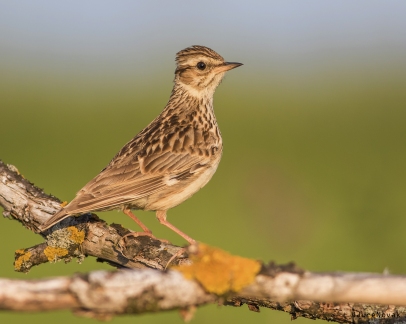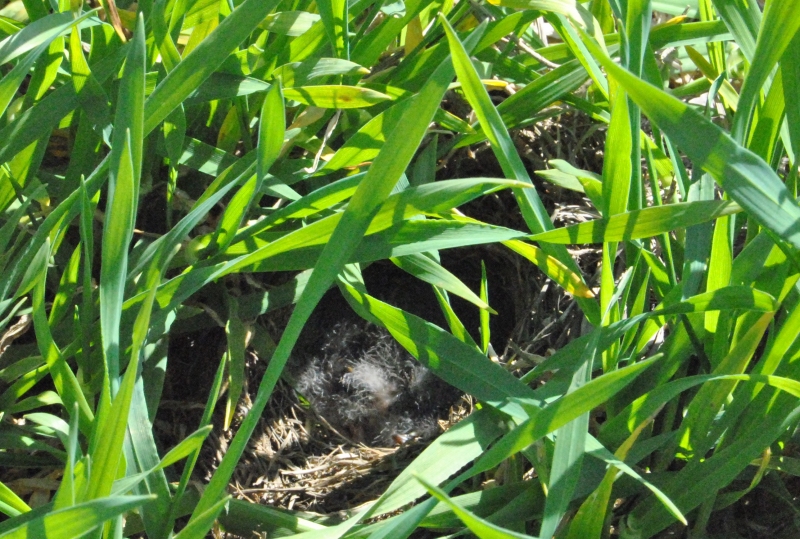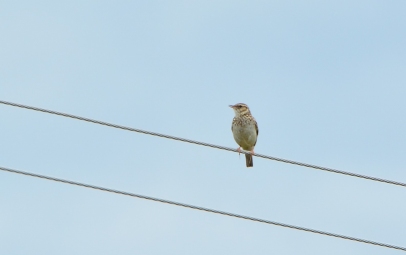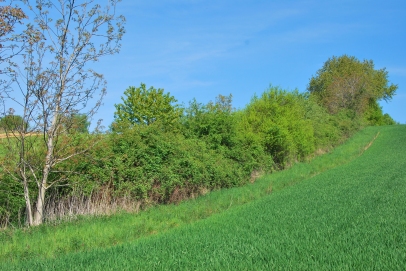Woodlark
In early spring melodious song of “lŇę-lŇę-lŇę-lŇę-lŇę toolooeet toolooeet toolooeet” echoes from the ridges of Gorińćko hilltops. This is the song of rare and endangered Woodlark (Lullula arborea).

Woodlark
Author: dr. Tomi Trilar
Slovenian Wildlife Sound Archive, Slovenian Museum of Natural History
Description
Woodlark is a small, up to 15 cm long bird with a wingspan up to 30 cm. Its feathers is mainly brown on the back and pale on the underside with a distinct white superciliar (white line above eye). Similar to other larks woodlark also has a crest on the top pf the head, but is often inconspicuous. It lives up to 5 years. Woodlark is easily recognized by its characteristic "undulating" flight. This noticeable flight pattern can be described as a flight in which the woodlark folds its wings and glides at regular intervals.
Woodlark often percheson the tops of trees ![]() G. Domanjko
G. Domanjko
Woodlark often perches on the tops of trees and tall bushes. Its song is one of the most melodious among European birds. It sing during undulating flight or from the top of the tree. With its singing males mark their territories and attract females. The first woodlark can in mild winters start to sing already in February.
Breeding
The pair builds their nest from grass, moss and roots in a small depression on the ground. Most often they breed on dry meadows or, as found in an ecological study in Gorińćko, on winter grain fields. The female lays 3-5 white eggs with brown spots, which she then incubates for 13-15 days. Chicks are fed by both parents for the next 11-13 days. The couple can raise two broods in a year.

Woodlarks nest on winter grain field ![]() M. Podletnik
M. Podletnik
Food
Insects and spiders are most often found on the menu of the woodlark. In winter they feed on seeds and green plant. In case of severe winters, woodlark can partially migrate to southern areas. In mild winters, individual birds even overwinter in Gorińćko Nature park. The habitat of the woodlark is a semi-open landscape, which include open forests with Scots pine and cultural landscape with meadows and fields. Woodlark predominately forage for food on dry meadows with sparse but diverse herbaceous vegetation. Significant are patches of bare ground or very low vegetation.

Patches of bare ground are important foraging habitat of woodlark ![]() M. Podletnik
M. Podletnik
Distribution and conservation status
Woodlark has a Eurasian spread. Populations in Europe and Slovenia are in a steep decline. The population in Slovenia is estimated on 3300-4400 breeding pairs. In Slovenia, it is locally distributed with two main densities. One on the SW part of Slovenia which includes Vipava Valley, Karst, SneŇĺnik - Pivka area and southern parts of Trnovski gozd. The second is Gorińćko Nature park. The population in Gorińćko has declined by 70 % in the last 20 years.
It is threatened by habitat loss due to intensification of agricultural land use as a result of intensfication of extensive meadows, removal of hedges and land abandonment on the other hand. It has the status of a highly endangered species (E2) and is protected in Slovenia. It is also a Natura 2000 target species for Gorińćko.










